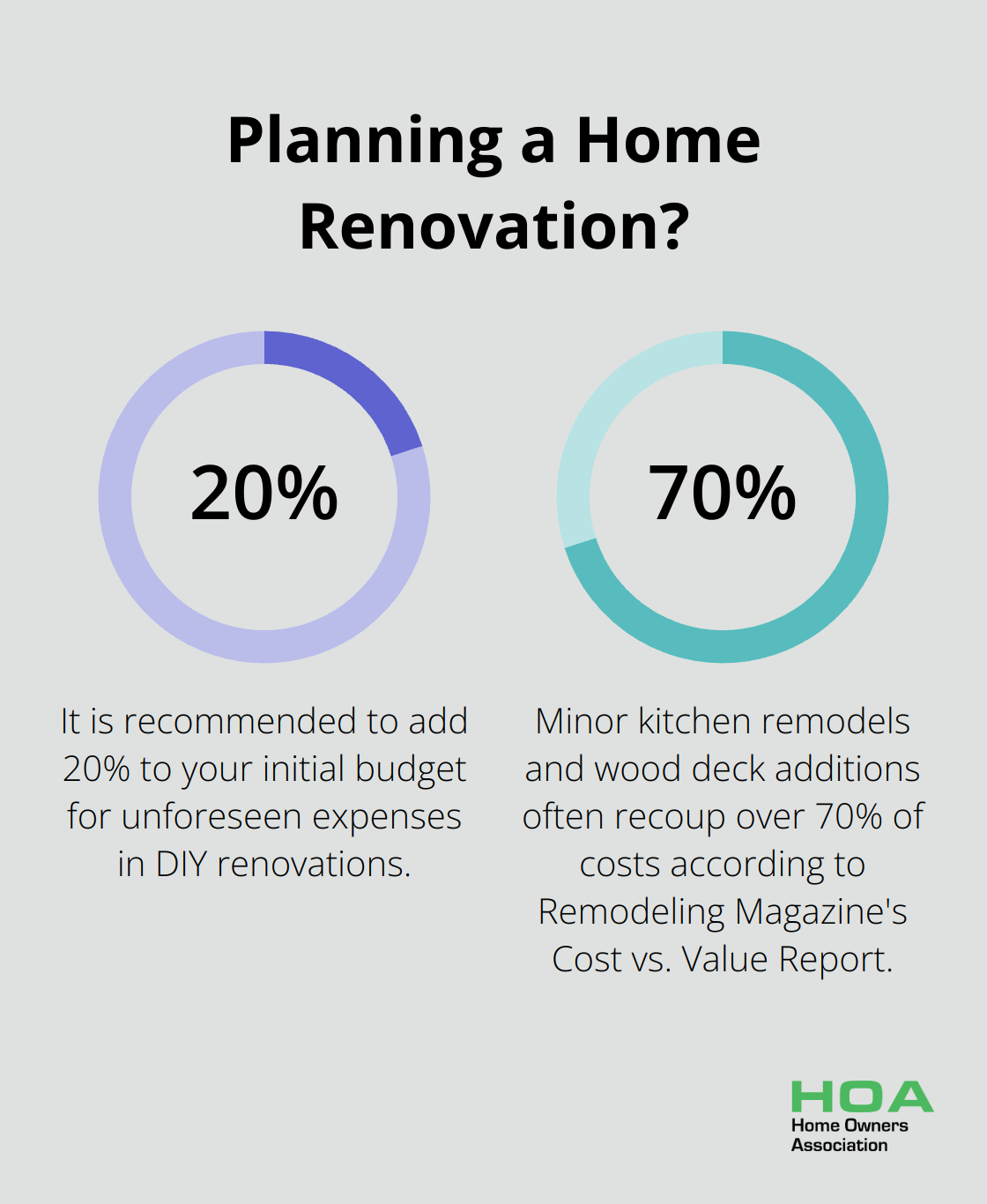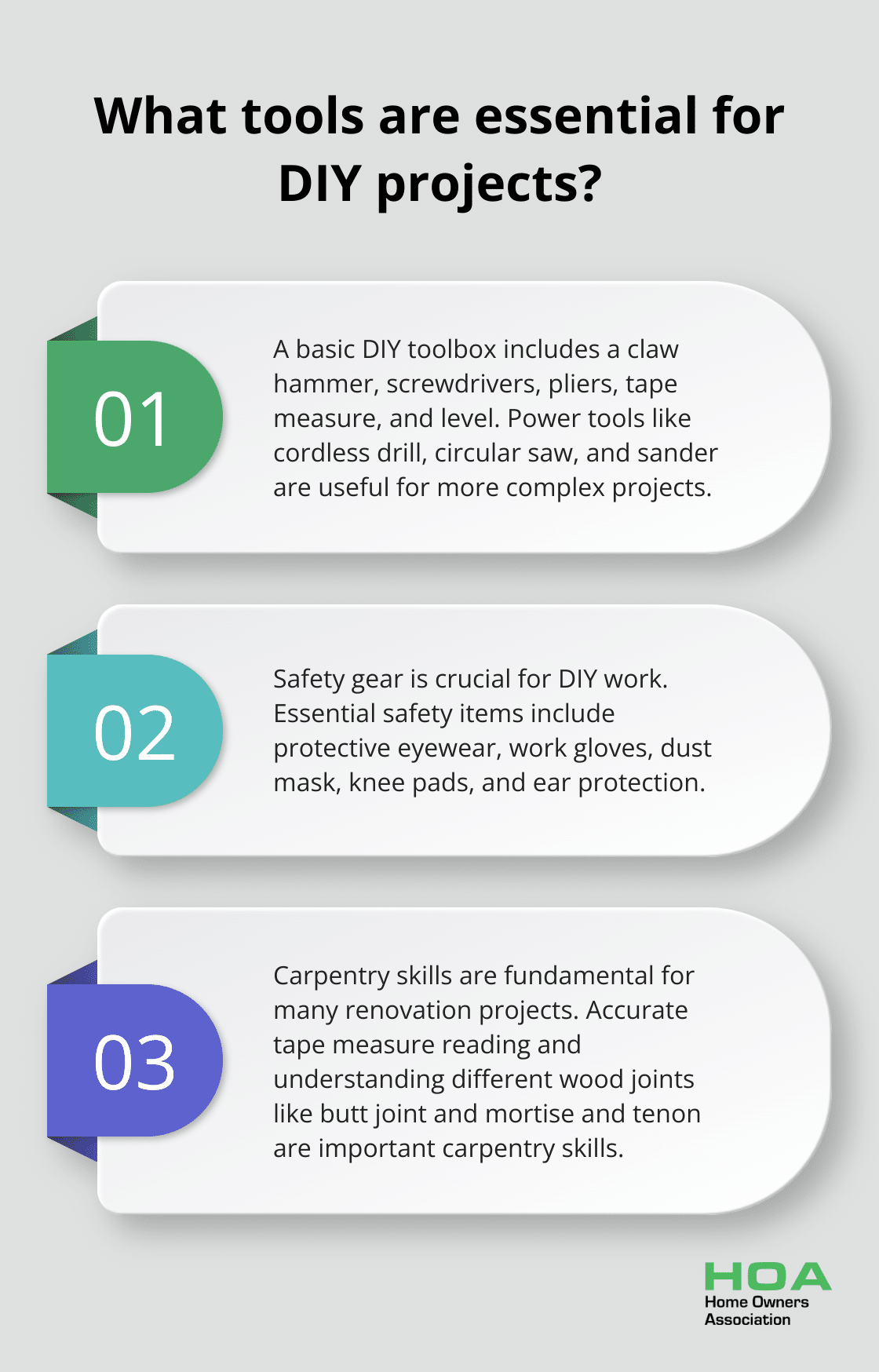
At Home Owners Association, we understand the allure of DIY home renovations. Transforming your living space can be both rewarding and cost-effective when done right.
This guide will walk you through essential steps to plan, execute, and succeed in your DIY home renovation projects. From refreshing walls to upgrading fixtures, we’ll cover practical techniques and tools to help you achieve professional-looking results.
How to Plan Your DIY Home Renovation
Planning forms the foundation of any successful DIY home renovation. A well-thought-out approach can make the difference between a smooth project and a stressful ordeal. Let’s explore the key steps to set yourself up for DIY success.
Evaluate Your Skills and Time
Before you start any project, take an honest look at your DIY abilities and available time. If you’ve never used a hammer, a complete kitchen remodel might prove too ambitious. Start with smaller projects like painting a room or replacing cabinet hardware. These tasks will build your confidence and skills for larger renovations.

Time is equally important. A bathroom renovation that professionals complete in a week might take you a month of weekends. Be realistic about your schedule and factor in unexpected delays. A survey by Houzz found that nearly half of homeowners are planning to renovate.
Create a Detailed Budget
Budgeting for a DIY renovation requires more than just estimating material costs. Include tools you’ll need to purchase or rent, permits, and a contingency fund for unexpected issues. Try to add 20% to your initial budget for unforeseen expenses.
Break down your budget into categories:
- Materials
- Tools
- Permits and inspections
- Waste removal
- Contingency fund
Keep in mind that while DIY can save on labor costs, it’s not always cheaper. Sometimes, the cost of tools and materials can outweigh professional labor charges, especially for specialized tasks.
Prioritize Your Projects
Not all renovations offer equal value. Some provide better return on investment (ROI) than others. According to Remodeling Magazine’s Cost vs. Value Report, minor kitchen remodels and wood deck additions consistently offer high ROI (often recouping over 70% of costs).
Consider the impact on your daily life too. Renovating a frequently used space like the kitchen will cause more disruption than updating a spare bedroom. Plan your project sequence to minimize inconvenience.
Navigate Building Codes and Permits
Ignoring local building codes and permit requirements can lead to costly fines and even forced removal of completed work. Contact your local council or building authority to understand what permits you need. Common projects requiring permits include:
- Structural changes
- Electrical work
- Plumbing alterations
- New windows or doors
Some areas have specific regulations for heritage properties or environmental considerations. Don’t assume that because you’re doing the work yourself, you can skip this step. Proper permits protect you and future homeowners.
Gather Essential Tools and Materials
Before you begin, make sure you have all the necessary tools and materials. This preparation will save you time and frustration once you start working. Create a comprehensive list and purchase or rent everything you need in advance. Don’t forget safety equipment like goggles, gloves, and dust masks.
With a solid plan in place, you’re ready to move on to the next exciting phase: selecting and executing your renovation projects. The following section will guide you through some high-impact DIY renovations that can transform your home without breaking the bank.
High-Impact DIY Projects to Transform Your Home
DIY projects can dramatically change your living space without breaking the bank. These projects offer a significant return on investment and can be accomplished by most homeowners with basic skills.
Revitalize Your Walls
A fresh coat of paint can completely change the feel of a room. When you select colors, consider the mood you want to create. Color psychology isn’t just art-it’s a blend of biology, physics, and design theory. By understanding LRV, undertones, and environmental factors, you can create the perfect atmosphere in your space.

For those who want to add texture and pattern, wallpaper is making a comeback. Modern peel-and-stick options make application easier than ever. A recent survey by Houzz found that 41% of homeowners chose to incorporate wallpaper in their renovation projects.
Kitchen Cabinet Makeover
Updating your kitchen cabinets can have a massive impact on the overall look of your kitchen without the cost of a full renovation. If your cabinets are in good condition, paint them. Light colors can make a small kitchen feel more spacious, while dark colors add drama and sophistication.
For a more budget-friendly option, simply replace the hardware. Choose hardware that complements your kitchen’s style – sleek and modern for contemporary spaces, or ornate for traditional kitchens.
Kitchen renovations can be done in steps, including demolition, tackling the ceiling and walls, transforming cabinets, updating tiles, and installing new appliances.
Flooring Facelift
New flooring can completely transform a room. While installing new floors might seem daunting, many modern flooring options are designed for DIY installation. Luxury vinyl plank (LVP) flooring is durable, water-resistant, and can mimic the look of hardwood at a fraction of the cost.
If you have existing hardwood floors that have seen better days, refinish them. Rent a floor sander and apply a new stain and finish to bring old floors back to life. This project typically costs about 30-50% less than installing new hardwood floors.
Lighting Upgrades
Update your lighting fixtures to modernize your home and improve functionality. Replace outdated fixtures with modern designs that complement your decor. Consider energy-efficient LED options to save on electricity bills in the long run.
Don’t forget about switches and outlets. Replace old, yellowed switches with modern options, or add dimmer switches to enhance the ambiance of your rooms. Smart switches that can be controlled via smartphone or voice commands are becoming increasingly popular (28% of renovating homeowners opt for smart lighting solutions according to the National Association of Home Builders).
As you embark on these transformative projects, keep in mind that patience and attention to detail are key. The next section will explore the essential tools and techniques that will help you achieve professional-looking results in your DIY renovations.
Mastering DIY Tools and Techniques
The DIY Toolbox Essentials
Every DIY enthusiast needs a well-stocked toolbox. Start with the basics: a claw hammer, screwdrivers (both flathead and Phillips), pliers, a tape measure, and a level. As you tackle more complex projects, expand your collection to include power tools like a cordless drill, circular saw, and sander. These tools will make your work faster and more precise.

Safety gear is non-negotiable. Protective eyewear, work gloves, and a dust mask are must-haves. For larger projects, invest in knee pads and ear protection. Safety should always be your top priority.
Carpentry Skills for Home Renovators
Carpentry forms the backbone of many renovation projects. Learn to read a tape measure accurately. This skill is essential for everything from hanging shelves to building custom furniture. Practice making straight cuts with a handsaw before you move on to power tools.
Understanding different types of wood joints is valuable. The butt joint is the simplest, while mortise and tenon joints offer more strength and stability. As you progress, study wood grain and how it affects your projects. This knowledge will help you choose the right materials and techniques for each task.
Paint Like a Pro
Painting is often considered an easy DIY task, but achieving a professional finish requires skill. Prepare your surfaces properly. Fill holes, sand rough spots, and clean thoroughly before you begin. Use painter’s tape for clean edges, but remove it before the paint fully dries to prevent peeling.
When it comes to application, invest in quality brushes and rollers. Cheap tools can leave streaks and shed bristles. Apply paint in thin, even coats, allowing proper drying time between layers. For a smooth finish on walls, try the “W” technique: paint a large W on the wall, then fill it in without lifting the roller.
Measure Twice, Cut Once
Accurate measurements are the foundation of successful renovations. Always double-check your measurements before you make cuts. When you measure for fitted items like countertops or built-in shelving, account for any irregularities in your walls or floors.
For precise cuts, mark your cutting line clearly and use a sharp blade. If you use a power saw, clamp your material securely and let the saw reach full speed before you make contact. Take your time and let the tool do the work – forcing the cut can lead to mistakes and potential injuries (not to mention ruined materials).
Continuous Learning and Improvement
The world of DIY is vast and ever-changing. Try to stay updated on new techniques and tools. Watch tutorials, attend workshops, and practice regularly. Each project you complete will add to your skill set and confidence. Start with smaller projects and work your way up to larger renovations as your abilities grow.
Final Thoughts
DIY home renovation projects offer homeowners the opportunity to transform their living spaces while developing valuable skills. The satisfaction of completing a project with your own hands surpasses the potential cost savings. We encourage you to start small, gradually tackling more complex renovations as your confidence grows.

For those in Melbourne seeking additional support for their DIY endeavors, Home Owners Association provides resources to ensure successful and cost-effective renovations. Our services include trade pricing on materials and expert advice to guide you through your projects.
Each DIY home renovation project presents a chance to learn, grow, and create a space that reflects your unique style. With the right tools, approach, and mindset (and perhaps a little help from us), you can transform your house into the home of your dreams.





